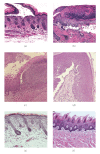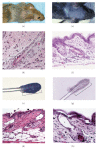Mouse models for blistering skin disorders
- PMID: 20585602
- PMCID: PMC2879910
- DOI: 10.1155/2010/584353
Mouse models for blistering skin disorders
Abstract
Genetically engineered mice have been essential tools for elucidating the pathological mechanisms underlying human diseases. In the case of diseases caused by impaired desmosome function, mouse models have helped to establish causal links between mutations and disease phenotypes. This review focuses on mice that lack the desmosomal cadherins desmoglein 3 or desmocollin 3 in stratified epithelia. A comparison of the phenotypes observed in these mouse lines is provided and the relationship between the mutant mouse phenotypes and human diseases, in particular pemphigus vulgaris, is discussed. Furthermore, we will discuss the advantages and potential limitations of genetically engineered mouse lines in our ongoing quest to understand blistering skin diseases.
Figures



Similar articles
-
Immunologic and histopathologic characterization of an active disease mouse model for pemphigus vulgaris.J Invest Dermatol. 2002 Jan;118(1):199-204. doi: 10.1046/j.0022-202x.2001.01643.x. J Invest Dermatol. 2002. PMID: 11851895
-
Upregulation of P-cadherin expression in the lesional skin of pemphigus, Hailey-Hailey disease and Darier's disease.J Cutan Pathol. 2001 Jul;28(6):277-81. doi: 10.1034/j.1600-0560.2001.028006277.x. J Cutan Pathol. 2001. PMID: 11401672
-
IgG binds to desmoglein 3 in desmosomes and causes a desmosomal split without keratin retraction in a pemphigus mouse model.J Invest Dermatol. 2004 May;122(5):1145-53. doi: 10.1111/j.0022-202X.2004.22426.x. J Invest Dermatol. 2004. PMID: 15140217
-
Defective cell-cell adhesion in the epidermis.Ciba Found Symp. 1995;189:107-20; discussion 120-3, 174-6. doi: 10.1002/9780470514719.ch9. Ciba Found Symp. 1995. PMID: 7587627 Review.
-
Pemphigus-A Disease of Desmosome Dysfunction Caused by Multiple Mechanisms.Front Immunol. 2018 Feb 1;9:136. doi: 10.3389/fimmu.2018.00136. eCollection 2018. Front Immunol. 2018. PMID: 29449846 Free PMC article. Review.
Cited by
-
A desmosomal cadherin controls multipotent hair follicle stem cell quiescence and orchestrates regeneration through adhesion signaling.iScience. 2023 Nov 25;26(12):108568. doi: 10.1016/j.isci.2023.108568. eCollection 2023 Dec 15. iScience. 2023. PMID: 38162019 Free PMC article.
-
Adherens Junctions and Desmosomes Coordinate Mechanics and Signaling to Orchestrate Tissue Morphogenesis and Function: An Evolutionary Perspective.Cold Spring Harb Perspect Biol. 2018 Nov 1;10(11):a029207. doi: 10.1101/cshperspect.a029207. Cold Spring Harb Perspect Biol. 2018. PMID: 28893859 Free PMC article. Review.
-
Plakoglobin as a regulator of desmocollin gene expression.J Invest Dermatol. 2013 Dec;133(12):2732-2740. doi: 10.1038/jid.2013.220. Epub 2013 May 7. J Invest Dermatol. 2013. PMID: 23652796 Free PMC article.
-
Desmosomal defects in acantholytic squamous cell carcinomas.J Cutan Pathol. 2014 Nov;41(11):873-9. doi: 10.1111/cup.12390. Epub 2014 Nov 4. J Cutan Pathol. 2014. PMID: 25264142 Free PMC article.
-
Integrating animal models and in vitro tissue models to elucidate the role of desmosomal proteins in diseases.Cell Commun Adhes. 2014 Feb;21(1):55-63. doi: 10.3109/15419061.2013.876015. Cell Commun Adhes. 2014. PMID: 24460201 Free PMC article. Review.
References
-
- Stanley JR, Amagai M. Pemphigus, bullous impetigo, and the staphylococcal scalded-skin syndrome. The New England Journal of Medicine. 2006;355(17):1800–1810. - PubMed
-
- Amagai M, Ahmed AR, Kitajima Y, et al. Are desmoglein autoantibodies essential for the immunopathogenesis of pemphigus vulgaris, or just “witnesses of disease”? Experimental Dermatology. 2006;15(10):815–831. - PubMed
-
- Schmidt A, Koch PJ. Desmosomes in development and diseases. In: Kowalczyk A, editor. LaFlamme S. Cell Junctions: Adhesion, Development and Disease. Weinheim, Germany: Wiley-VCH; pp. 235–249.
-
- Koch PJ, Mahoney MG, Cotsarelis G, Rothenberger K, Lavker RM, Stanley JR. Desmoglein 3 anchors telogen hair in the follicle. Journal of Cell Science. 1998;111(17):2529–2537. - PubMed
Grants and funding
LinkOut - more resources
Full Text Sources

